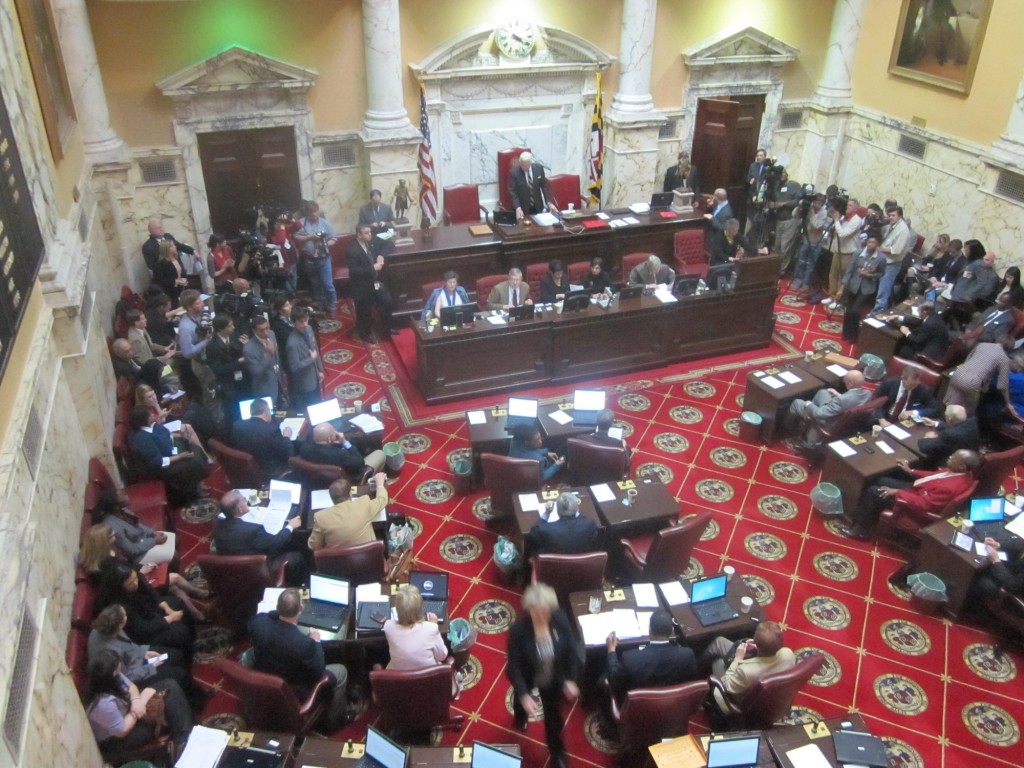16% raise recommended for Maryland legislators who would make $50,000 in 2018
By Len Lazarick

Former Delegate Barbara Kreamer testifies to the General Assembly Compensation Commission Monday. From right, they are Kreamer; Raymond Nix; chairman Sean Glynn; Mary Larkin; Steuart Chaney; and Ackneil M. Muldrow III. All but Chaney are appointed by the governor.
Maryland legislators elected next year would see their salaries rise to $50,330 in 2018, a 16% raise over the next four years recommended Monday by the General Assembly Compensation Commission.
If the legislature accepts the recommendation, it would give the part-time lawmakers their first raise in eight years. Delegates and senators currently make $43,500.
The two presiding officers would also get a 16% pay hike over four years to $65,371 in 2018. The Senate president and House of Delegates speaker currently make $56,500.
The nine-member commission also proposed some of the same adjustments to legislative pensions that the General Assembly imposed on state employees and teachers in 2011. The commission suggested raising legislators’ contribution rate from 5% to 7% of their salaries, raising the retirement age from 60 to 62, and raising the early retirement age from 50 to 55.
Consensus on pay hike
“There was general consensus all the way through from the first meeting [that some increase was justified],” said attorney Sean Glynn, appointed by Gov. Martin O’Malley to chair the commission, as he did four years ago.
In 2010, the commission proposed small increases in General Assembly pay, but only if unemployment fell below 5%. The legislature rejected those increases, and even if they had been approved, they would not have taken effect since the unemployment rate has remained over 6%.
“There was a big sense of fiscal responsibility all along,” said Glynn.
The recommendation for the pay hike passed by a 7-2 vote. Anne Arundel County Marina owner Steuart Chaney was one of the dissenters, favoring a smaller increase.
Chaney, who was appointed by Senate President Mike Miller, said he spoke to legislators and “the legislators thought the compensation was reasonable” at the current level.
But with adjustments to the pensions, Chaney thought some increase was justified.
Part-time legislators, but 42 have no other job
The Maryland legislature is part-time, meeting for 90 days from January to April, with committee meetings and local constituent work throughout the year. About one of out of five Maryland legislators (42 members or 21%) have no other employment, according to a membership profile done by the Department of Legislative Services.
(That is a higher number than reported to the commission in an extensive briefing paper from staff, based on comparative data from National Conference of State Legislatures.)
“From a fairness point of view we should give them what state employees got” over the past seven years, said Gene Ransom III, a former Queen Anne’s County commissioner who is CEO of MedChi, the state medical society.
Legislative staff provided the commission a range of options for salary increases, based on different methods for calculating state pay and the potential for cost of living increases.
Legislative pensions still more generous
While bringing some of the provisions of legislative pensions in line with those for regular state employees and teachers, the commission left intact the more generous pensions for members of the General Assembly.
The senators and delegates earn pensions worth 3% of the salary of current members for every year of service, capped at two-thirds of salary after 22 years and three months of service. They are entitled to some retirement benefits after eight years (two terms) in office.
Employees earn pensions worth 1.5% per year, but with no cap. Employees hired before 2012 are vested after five years of service; newer employees are vested after 10 years.
But unlike state employees, who receive pensions based on their lifetime earnings and any cost of living adjustments, legislative pensions go up based on the current salaries of legislators. This means that retired legislators would also see their retirement pay go up 16% from 2015 to 2018.
There are currently 174 retired legislators with an average age of 74 who get an average pension of $17,376 per year. There are 57 people receiving survivor benefits as spouses or dependent children averaging $9,200 a year.
The average salary for current state employees is $47,030 and about 41,000 retired state workers receive an average pension of $12,000 a year.
According to the briefing documents on pensions, 28 members of the current legislature with an average age of 69 are already entitled to the maximum pension of $29,145 a year. That will go up to $37,000 in 2018. Of the 188 members of the House and Senate, 115 currently have at least eight years of service, and are vested in pensions.
Reject plea from former delegate for more years of credit
The commission rejected a plea by former Del. Barbara Kreamer of Harford County to change the legislative pension system so she could receive credit for her service on the County Council and as a teacher. She did not serve in either job long enough to be vested in the state pension system.
“That was unfair,” Kreamer told the commission.
The commission did request the legislative staff consider changes in legislative pensions that would allow credit for military service and other state employment.
Kreamer served in the legislature from 1983 to 1990. The salary at that time was $21,000 in the first term and rose to $25,000 by the end of her second term. Based on eight years of service, the former delegate would currently be entitled to 24% of the current salary or $10,440 a year.

MarylandReporter.com is a daily news website produced by journalists committed to making state government as open, transparent, accountable and responsive as possible – in deed, not just in promise. We believe the people who pay for this government are entitled to have their money spent in an efficient and effective way, and that they are entitled to keep as much of their hard-earned dollars as they possibly can.


